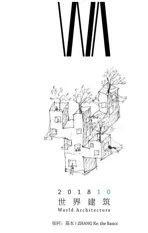“微胡同”,北京,中国
2018-10-27建筑设计标准营造
建筑设计:标准营造
在传统北京胡同院落的局促空间中,“微胡同”项目以35m2的主体建筑面积,进行了极小尺度的居住实验。
设计将庭院回归到流线组织的重心,通过将活动空间引入到建筑内部庭院,来创造与城市文脉的直接联系。庭院不仅提升了内部空气与光线的流动,也联结着形式多样的方形体量及面向城市的门廊。这个灵活的城市居住空间成为位于较私密生活空间与具城市性的街道间的过渡空间,同时也成为可供“微胡同”居民及社区邻居共同使用的半公共空间。
“微胡同”建筑主体是由墨汁混凝土现场浇筑而成——墨汁与混凝土按一定比例调配,使得材料最终呈现一种特有的色调。提升和改善胡同空间的生活条件是“微胡同”的设计核心之一。现代中央空调系统服务整个主体建筑的同时,房间中都布置了地暖,这使得即使在寒冷的北京冬季,使用者都可以在舒适的建筑室内环境中,透过整体透明的房间立面,欣赏户外景致。建筑屋顶设计了3个可机械控制开启的天窗,每个房间侧面也设置了开启扇,由此保证了建筑室内的自然通风。
在提升空间品质的同时,“微胡同”在空间形态上延续了传统胡同院落的尺度感,并强化了空间的社会属性。□
The goal of this project, a house of 35m2, is to study possibilities of creating social housing on ultra-small scale within the limitations of excessively small traditional hutong spaces of Beijing.
The result is an architectural operation that brings back the courtyard as a generator of the programme, as it activates the building by creating a direct relationship with its urban context. Apart from enhancing the flow of air and light, the courtyard creates a direct relationship between the living space contained in dynamic volumes and an urban vestibule in the front part of the building. This flexible urban living room acts as a transitional zone from the private rooms to the street, while serving as a semipublic space to be used by both the inhabitants of the house and the neighbours of the community.
The main body of the project was on-site cast by the concrete mixed with Chinese ink, including mini living spaces with a shared courtyard, which is a public area with two trees faced by five inward staggered rooms. As part of the design to improve the quality of life in the hutong, the main building is supported by the central air-conditioning system,with radiant floor in each room to provide a comfortable interior situation against the severely cold winter weather in Beijing, when a dramatic view is framed by the entirely transparent facade of every room. Besides the three operable skylights on the roof, all the rooms give possibilities to natural ventilation allowing the fresh air flow to circulate through the whole building.
"Micro Hutong" inherits the intimate scale of the traditional hutong, revitalising its social condensing capabilities with spatial improvements.□

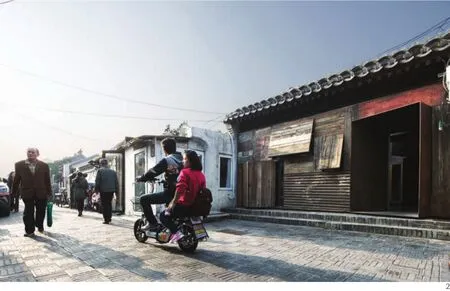
1 总平面/Site plan
2 外景/Exterior view
3 庭院/Courtyard
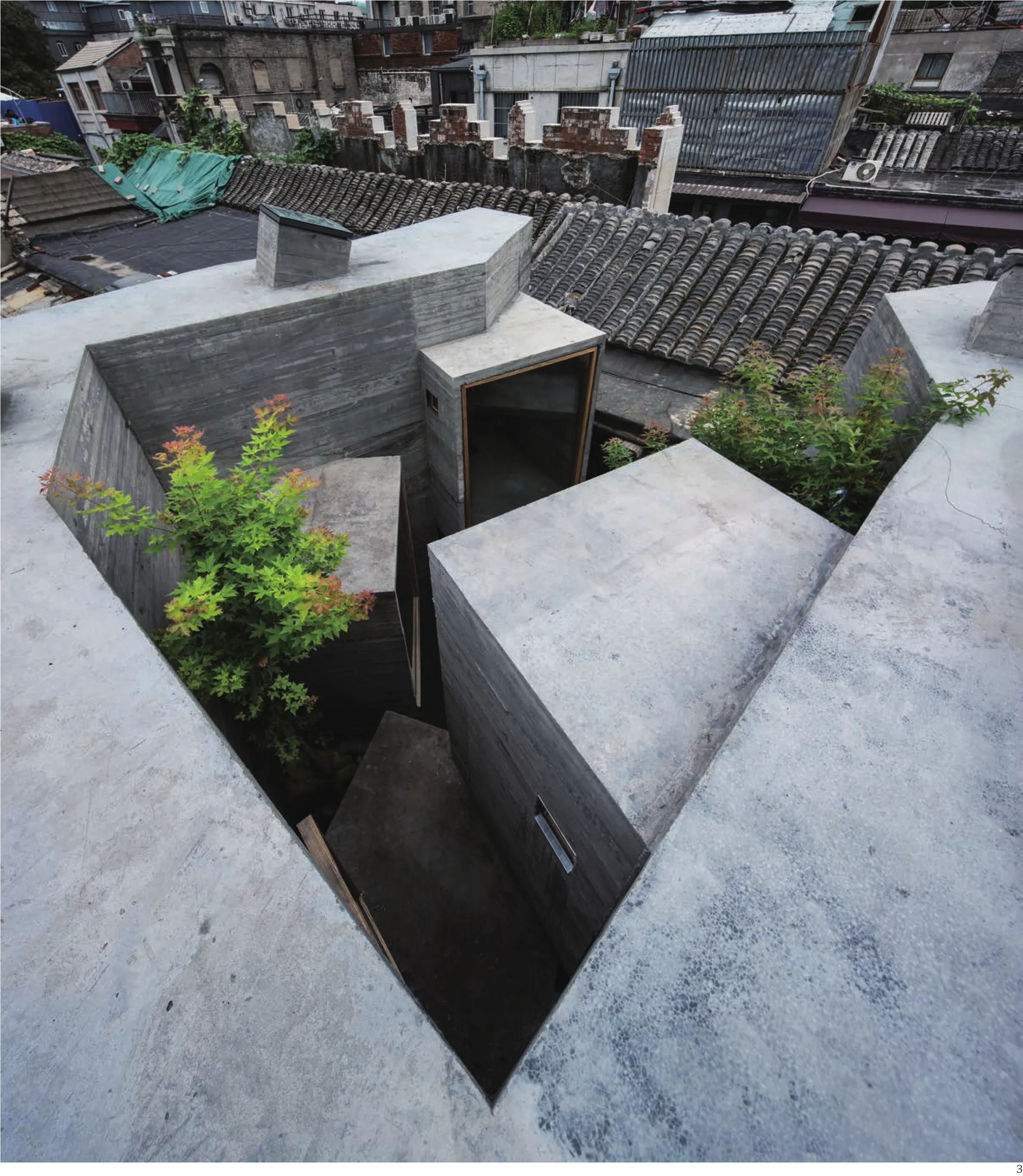

4-7 内景/Interior views





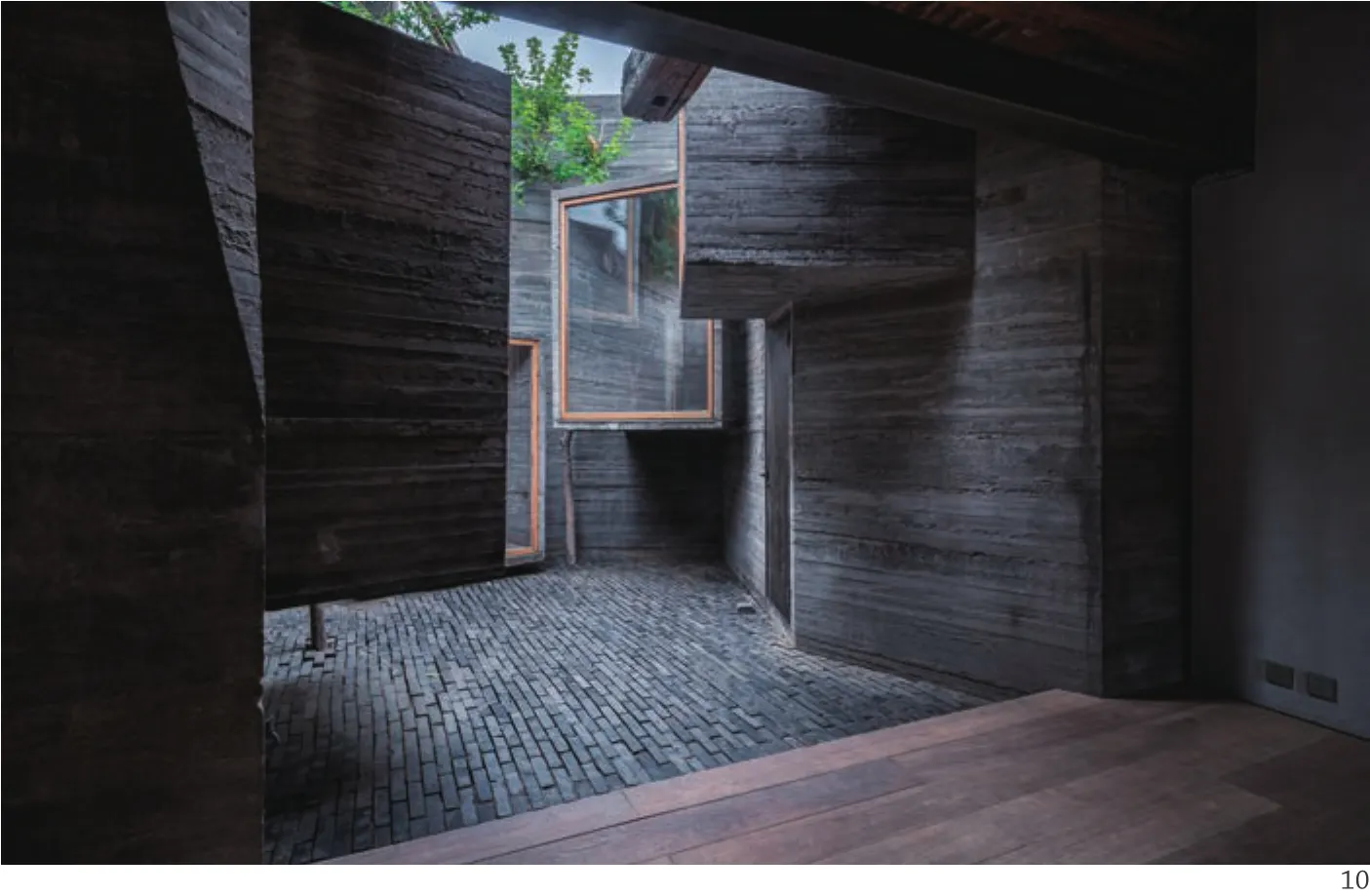
8-10 外景/Exteriorviews
11 首层平面/Ground floor plan
12 二层平面/1st floor plan
13-16 剖面/Sections
1-庭院/Courtyard
2-展室/Exhibition room
3-餐室/Dining room
4-厨房/Kitchen
5-卫生间/Toilet
6-走廊/Corridor
7-卧室/Bedroom
8-学习室/Study room
9-茶室/Tea house
10-露台/Terrace


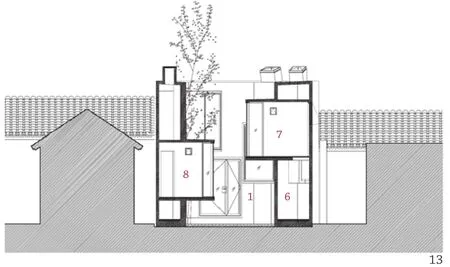




17 庭院/Courtyard
评论
鲍威:北京胡同界面被人感知最多的有两个,一是代表群像的街道,二是代表个像的庭院。然而另一个向度的界面却更能够反映出胡同的全像,即连续的屋顶界面。标准营造的作品向来以其建筑单体强烈的形式操作来回应一系列的问题,微胡同项目也不例外。然而此案在北京旧城的环境背景下,是否能在这群像、个像及全像这三个层面上获得成功?我们不妨从胡同的街道、庭院、屋顶这三个界面对其进行解读。
微胡同的街道界面是封闭的,除了入户门,其余立面为旧材料拼成的立面构成,这与本来封闭的传统胡同界面一致,虽然其身处的杨梅竹斜街开放的商业界面是非典型的胡同界面。微胡同的庭院界面为设计的建筑主体,C字形的主干加上一系列的悬挑盒子准确地创造出了一个内向的、统一的、功能复杂的、体验性极强的庭院界面。毫无疑问,微胡同对这两个界面的应答都是相当成功的。而微胡同的屋顶界面,即为平面逻辑的直接呈现:平面边界直接拉高,超出周围环境的高度,所有即所得。这种处理是否与城市的屋顶界面一致?
胡同建筑屋顶的神奇之处在于其尺度的升级:平面上建筑变化丰富,而屋顶永远是双坡统一一切。在这个界面上,大尺度的屋顶将下边琐碎的小尺度平面活动全部隐藏,呈现出城市统一的全像。微胡同小尺度的平面逻辑直接侵入到这个大尺度的屋顶景观中来,不免造成了尺度上的冲突。
并非说这种只在乎自身形式操作的做法有何不妥,而是说以另外两种方式的处理是否会更具优势:屋顶是否可以在尺度上和周围建筑形成统一,完成从小尺度的平面逻辑到大尺度的屋顶逻辑的转化?抑或建筑高度不侵入到连续的屋顶界面中来,如同不远处的微杂院那样,谦和地隐退在周围屋面景观之下?
Comment
BAO Wei:Two interfaces of Beijing's hutong are most often perceived by people: one is the street standing for group image; the other a courtyard standing for single image. However, an interface of another dimension can reflect the full image of Hutong, that is, the continuous interface of roofs.The works of ZAO have always responded to a series of questions with strong manipulations of form over single buildings, and the Micro-hutong project is no exception. However, in the environmental context of the old city of Beijing, may this case succeed on the three levels of group image, single image, and panoramic image? We may interpret it from the three interfaces of streets, courtyards and roofs of hutong.The street interface of the Micro-hutong is closed. Apart from the entrance door, the other parts of the facades are pieced together with old materials.That is consistent with the original closed interface of traditional hutong, although the open commercial interface of Yangmeizhu Oblique Street where it's located is an atypical Hutong interface. The courtyard interface of the Micro-hutong is the main body of the design. The C-shaped backbone plus a series of suspended boxes accurately create an inward, unified courtyard interface with complex functions and rich experiences. There is no doubt that the Microhutong's responses to these two interfaces are quite successful. The roof interface of the Micro-hutong,however, is a direct representation of the planar logic:the boundary of the floor plan is directly raised above the height of the surrounding environment. What there is what obtained. Is this method consistent with roofscape of the city?
The magic of the roofs of hutong lies in the upgrade of scales: buildings vary widely in plans, but in terms of roofs, the double-pitch always controls everything. On this interface, the large-scale roofs hide all the trivial small-scale planar activities underneath, presenting a unified full image of the city. The small-scale planar logic of the Micro-hutong intrudes directly into the large-scale landscape of roofs, naturally resulting in conflicts of scales.
This is not to say that it's wrong to care only about its own manipulation of form, but whether could two others ways be more optimised or not: Could the roof unify with the surrounding buildings in terms of scale, to complete the transformation from smallscale planar logic to large-scale roof logic? Or could the height of the building not intrude into the continuous roof interface, like micro courtyard not far away, and humbly retreat beneath the landscape of surrounding roofs? (Translated by CHEN Yuxiao)
